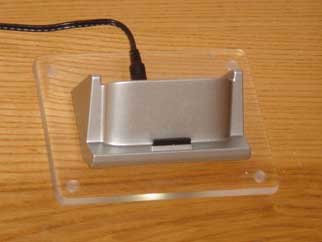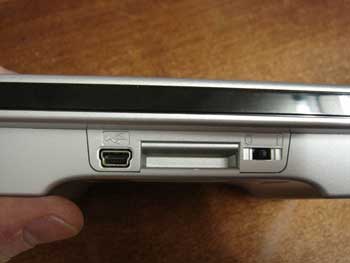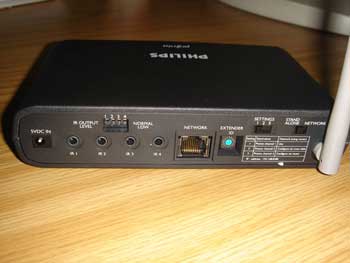The buttons are strategically placed on the
right hand side (not so good for left handed folks). They are mostly
accessible through the right thumb. The remote is much lighter than it might
appear. It is designed to fit very snugly in your right hand while still
allowing your thumb to quickly flip through the channels, looking for that
critical episode of CSI you might have missed.
 Still, if you're doing anything more than
flipping channels, you'll need two hands for this remote. Whereas I could do
virtually everything using one handed operations on previous Prontos, this
is clearly too large a remote to do that. You simply hold the remote with
one hand and use the other hand to control things on-screen.
Still, if you're doing anything more than
flipping channels, you'll need two hands for this remote. Whereas I could do
virtually everything using one handed operations on previous Prontos, this
is clearly too large a remote to do that. You simply hold the remote with
one hand and use the other hand to control things on-screen.
Hardware button-wise, there are several new
hard keys, including five keys below the screen: Menus key, EPG button,
Channel, Volume/Mute, Power button, and Page Up/Down buttons (which can
now be programmed).
The remote comes with a stylus, although I never need to
use it, and it seems like that item will be a common complaint as it is way
too easy to lose (there should have been some kind of string or wire
attached to prevent it from getting lost).
The remote charges on a transparent base where
it stands almost upright. The base is transparent and is lit up with white
LEDs when powered on. When the remote is charging, a red light appears below
it. In a dark room, this can be quite a spectacle. It is definitely a very
cool look.
 The
9600 comes with quite an advanced
software package: the Pronto Edit Professional. This is yet another version of the
software that can read older designs and support the phone in full. For the
first time, the built-in template design comes with transition screens –
animation screens that help you pass the time when you turn on your system
and a long macro has to turn on your display, A/V receiver, switch them all
to the appropriate inputs, switch to a particular channel and then to a
particular channel, change aspect ratio, set the volume level, etc. Macros
can have up to 250 steps, but given that one macro can also make another
macro start running, you have endless possibilities.
The
9600 comes with quite an advanced
software package: the Pronto Edit Professional. This is yet another version of the
software that can read older designs and support the phone in full. For the
first time, the built-in template design comes with transition screens –
animation screens that help you pass the time when you turn on your system
and a long macro has to turn on your display, A/V receiver, switch them all
to the appropriate inputs, switch to a particular channel and then to a
particular channel, change aspect ratio, set the volume level, etc. Macros
can have up to 250 steps, but given that one macro can also make another
macro start running, you have endless possibilities.
The software allows you to import graphics
from the Philips gallery (which is quite extensive), and in the near future,
I'm sure Remote Central will also add their own gallery and designs to the
mix.
Button graphics are in the new PNG
alpha-blended format, which not only allows for a reasonable size
compression with big files, but also allows for transparency control. This
will let you create buttons that throw shadows or light up their
surroundings. This, combined with such an amazing screen and a much faster
CPU, completes complex macros much faster than any previous Pronto remote
I've tested.
The difference in speed between the TSU9600
and the previous generation of products (TSU7000/7500 Pronto Pro, or
RU980/990) is just amazing. They really did revamp everything.
Additional features now include much smarter
capabilities on the software side. You can distinguish buttons that
function globally (e.g., volume should always be controlled on my A/V
receiver) from those that are done locally (channel up and down should work
different depending on which screen you are on). You can assign
particular devices to a screen, which makes creating new buttons and macros
much easier to do. It still takes quite a while to work everything out,
particularly when you have lots of devices in your home theater (or entire
house, as you can automate everything with this remote). A wizard-based
system to start things off would have saved a serious amount of effort and
time.
Here is a separate page showing screen shots of the software.
The end result of the software is a new XCF
format. With other Prontos, you could download this file to your Pronto or
upload it back if you needed to. This version only allows you to download
the files to your Pronto. I assume the reason is that custom installers were
tired of having their expensive designs shared by different users and even
shared on the Internet. Now, only the person who has the original file can
modify it.
A nice idea, "borrowed" from Microsoft Power
Point ™, is Pack-N-Go, which allows a custom installer to create an EXE file
that the end-user runs and automatically uploads the modified design to the
remote. This saves custom installers the bi-monthly call that sounds a lot
like "press that menu button to load the file, did you do it? Now, click
upload to Pronto". Since it doesn't expose the actual file, users can keep
a copy of their design, without being able to change it or "share" it with
their friends or on the Internet.
 The
9600 comes with Wi-Fi capabilities. This
serves to control other devices on the network (essentially Lutron and
Escient systems). In the near future, Philips will also introduce a way to
control your HTPC (through MCE) directly on your Pronto. WI-FI means it will
have two-way control and will be able to verify each operation before
proceeding to the next step.
The
9600 comes with Wi-Fi capabilities. This
serves to control other devices on the network (essentially Lutron and
Escient systems). In the near future, Philips will also introduce a way to
control your HTPC (through MCE) directly on your Pronto. WI-FI means it will
have two-way control and will be able to verify each operation before
proceeding to the next step.
If your computer is out of range, it will not
continue to switching your TV to display it. Two-way control means you can
also see what the unit is doing at any given time. With Escient, that means
you can see your song collection and can flip through it using the circular
silver jog dial surrounding the cursor buttons. Unfortunately, this button is
not addressable through the Pronto professional software, which means that
if you don't have a similar Escient Fireball server at home, you won't be
able to use that hard button yet.
Click Here to Go to Part III.